Counter-Hybrid Warfare: Winning in the Gray Zone
Gary Anderson
The United States is actively involved in two hybrid conflicts (ISIS in Syria and Iraq) and is supporting the Ukraine against hybrid threats from Russia. That said, America lacks a formal doctrine for dealing with such conflicts or even an agreed-on doctrinal definition of what they are. This article is an attempt to begin a serious discussion of a doctrinal approach to counter attempts by other state actors to use kinetic hybrid techniques to further state interests in ways harmful to us. The Hybrid Center of Excellence in Finland is a good start to begin examining cooperative approaches to countering hybrid threats, but the United State will likely play a key role when a NATO ally or a partner with which we have a bilateral security agreement comes under a hybrid attack.
What is Hybrid Warfare?
In 2011, the Army was talking about the hybrid threat as "the diverse and dynamic combination of regular forces, irregular forces, criminal elements, or a combination of these forces and elements all unified to achieve mutually benefiting effects". [1] It should be noted that this definition only refers to a threat, not to a type of warfare. Most thinkers on the subject also refer to cyber-attacks, disinformation (fake news) election tampering as elements of the hybrid threat. For purposes of this discussion, we will define state sponsored hybrid warfare as follows: “An attempt by a state actor to achieve policy objectives through the use of kinetic and non-kinetic means in such a manner that it cannot be tied to the conflict as a direct belligerent.”
Dr. Frank Hoffman has an extensive discussion of the relationship between hybrid actors and the Gray Zone between peace and war in the November 2018 issue of PRISM which may go a long way toward clarifying the US doctrinal approach to hybrid conflict. [2] Hoffman did the defining work of identifying hybrid warfare as unique from pure insurgency and conventional conflict while working for the Marine Corps Center for Emerging Threats and Opportunities fifteen years ago, and he should probably have a say in coming up with a final doctrinal definition.
Prior to the end of the Cold War, nations were much less prone to deny the use of non-state surrogates. The Americans and British both used non-state sponsored militias in the American Revolution. The Spanish and British governments used un-uniformed guerillas against Napoleon, and both sides used non-state forces during the Spanish Civil War. However, in all three cases, the irregular forces were not mere auxiliaries. They contributed heavily to the outcome. In that context, the American Civil War was not a hybrid war because guerillas such as Mosby and the irregular militias in the border states were not key to the conflict. The same can be said of partisans and resistance movements in World War II.
The period of the Vietnam War from 1962 to 1968 would fit the definition of hybrid war until the Tet Offensive in 1968 when the Viet Cong ceased to exist as a serious military threat. We know now that the Viet Cong movement was totally controlled by Hanoi, but many Americans still believe that it was a native movement within South Vietnam. After Tet, the conflict became largely a conventional civil war between Hanoi and Saigon. This was especially true after American involvement effectively ended in 1973.
The first truly modern hybrid war was the Soviet-Afghan conflict of 1979-80. Although, the anti-Soviet son-state Mujahedeen did most of the fighting against the Red Army and its Afghan puppet government, the United States provided the modern arms and technical advisors that kept the insurgents in the field. The Americans were careful to avoid direct conflict with Soviet forces.
However, the end of the Cold War saw the true flowering of modern hybrid warfare. Beginning with the Balkans war in the former Yugoslavia, Serbia found it useful to use non-state militias to carry out actions that could be considered genocide or ethnic cleansing in order to avoid UN sanctions and NATO intervention. It worked for a while, but eventually the depredations of such forces caused UN and NATO intervention. In other words, the Serbians finally got caught crossing the line out from the Gray Zone that lies between peace and war and caused an international kinetic action against them. Since that time, state actors have become more sophisticated in their approach to hybrid conflict.
The overthrow of the Taliban in Afghanistan following 9-11 was a state-sponsored hybrid effort by the United States. The loosely organized non-state Northern Alliance was supported by American airpower and special operations forces, but the Northern Alliance did most of the fighting that overthrew the Taliban. Because the Taliban had no overt state sponsored champions of their own, the United States was more open about its support of the rebel alliance than in most modern hybrid endeavors.
What Hybrid Warfare is Not
The difference between a hybrid war and an insurgency is that a pure insurgency is a home-grown affair. It may have outside help, but the leadership is indigenous to the nation or region. In a state sponsored hybrid war, the real leadership comes from a state actor. Usually it is an attempt by the state-sponsor to regain territory or an ethnic population lost in an earlier conflict or negotiation or to overthrow a regime not aligned with the sponsoring state’s interests. Some of the tools used in counterinsurgency can be employed to defeat hybrid threats, but the two types of conflict have distinct characteristics that make treating a hybrid threat as a pure insurgency a dangerous mistake.
The United States has been successful in waging hybrid wars against the Soviets and Taliban in Afghanistan, and It also used hybrid approaches to destroy the would-be Islamic State in Iraq and Syria. These were all inelegant, ad-hoc approaches. The war against ISIS in Syria and Iraq was disastrous for non-combatants who got in the way; but the approach worked. That said, creating a doctrinal American approach to countering hybrid warfare in support of friendly nations is still very much a work in progress.
Hybrid Warfare in the Russian Near Abroad
The future potential hybrid threats that should most be of the most immediate concern American to American planners will be attempts by Russia to reclaim parts of the old Soviet Union that have heavy Russian ethic populations because these include several NATO allies.
The Russians have had mixed success in the use of hybrid warfare. Their re-annexation of Chechnya and the Crimea made heavy use of techniques associated with hybrid approaches- they were successes, as was the use of hybrid techniques create the separatist state of South Ossetia from the Republic of Georgia. However, Russian attempts to reabsorb areas of the Eastern Ukraine with heavy Russian ethnic populations have been decidedly mixed.
Russian intervention in Syria has decidedly counter-hybrid overtones in defense of the Assad regime, but both the Russians and Iranians appear to be finding that propping up the weak Assad government has unanticipated costs. Despite these setbacks, the Russians appear to be continuing to attempt to use hybrid methods to further national objectives in the Gray Zone between peace and conventional war. To date in eastern Ukraine, the lack of a Ukrainian alliance with NATO or another partner has allowed the Russians to verge very close to the zone of conventional conflict (let’s use the term Black Zone) without actually crossing the line. As a NATO member, the United States has a vested interest in both deterring and countering such Russian adventurism in the Baltic States and other NATO members with Russian ethnic minorities; but we want to keep clear of a conventional conflict on Russian home turf.
Campaign Planning in Counter-Hybrid Warfare
A campaign consists of a number of battles and engagements designed to achieve a strategic objective. This is particularly true of hybrid warfare where a single battle will not usually deal with the problem. The differences between planning a conventional military campaign and a counter-hybrid campaign in support of a host nation (HN) are twofold:
First, as in counterinsurgency, the HN should be in the lead, with the United States filling in capabilities gaps in areas where the HN lacks the resources.
Second, all elements of national power of both US and HN DIME (diplomatic, information, military, and economic) must be targeted at much more local levels than in general conventional conflicts. The diplomatic aspect is critical here. If the state sponsor of a separatist movement manages to orchestrate the liberation of a region of the host nation and organize a referendum to create a separate state, it is imperative that that separatist “state” does not receive the legitimacy of international recognition. This is where US diplomacy becomes key.
Assumptions
All plans have assumptions and counter-hybrid plans are no exception. The key assumption here is that the state sponsor of the hybrid threat does not want to initiate a conventional conflict with the United States and/or NATO (by tripping a regional or bi-lateral alliance) and will attempt to keep the conflict in the Gray Zone. There may be other assumptions, but plausible deniability of the worst excesses of a conflict is key to a successful state-sponsored hybrid campaign.
The Weaknesses of Hybrid Warfare
Any campaign plan must take into consideration the key vulnerabilities of the opponent and consider ways to exploit them. A state-sponsored hybrid threat has three key vulnerabilities:
First, hybrid warfare doesn’t always work. In the conventional conflicts of the 19th and 20th century, the side that initiated the conflict succeeded in achieving its major goals only fifty percent of the time. That itself is not a great average, but modern hybrid conflicts have had even more marginal success rates.
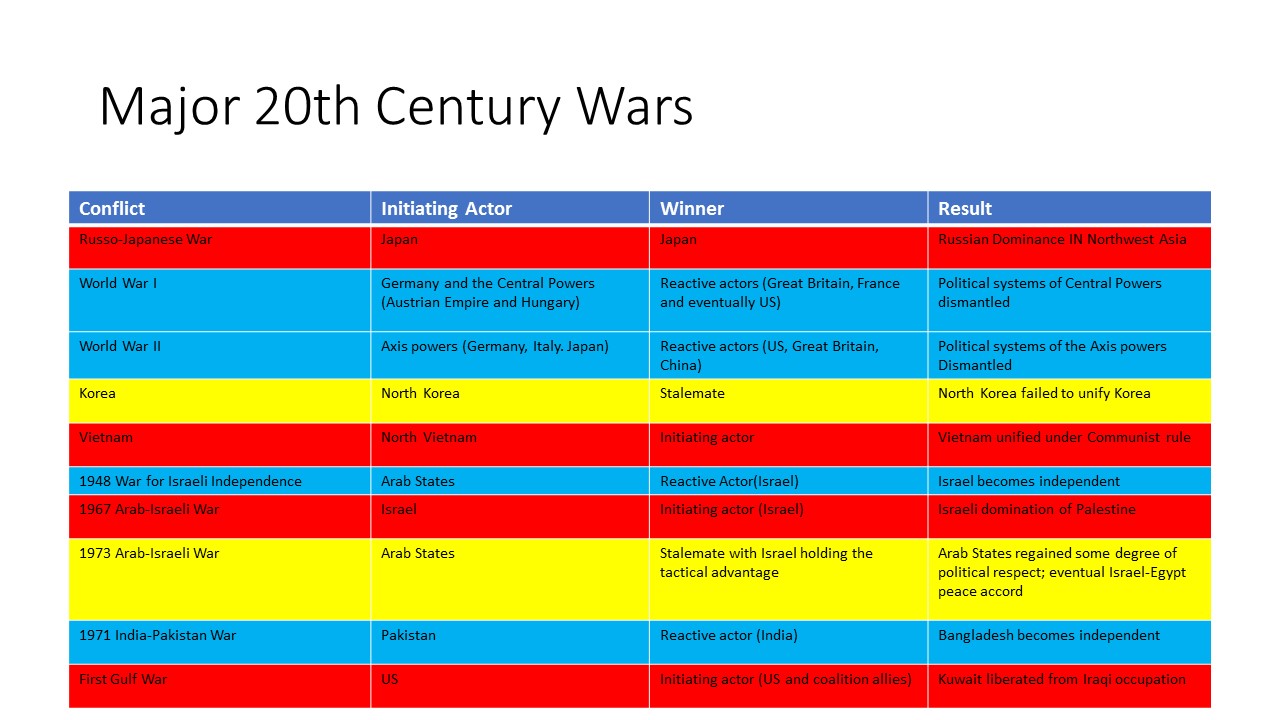
Figure 1. The lines in red indicate conventional wars where the initiating side achieved all of its objectives. The figures in blue indicate wars that the initiating actor clearly lost, and those in yellow are those where a stalemate occurred, and the initiator’s strategic objectives were not achieved satisfactorily or only partially achieved. Of the two stalemates, Korea was a clear failure for the initiator- but the 1973 Arab-Israeli war saw the Arab initiators gain some of their strategic objectives.
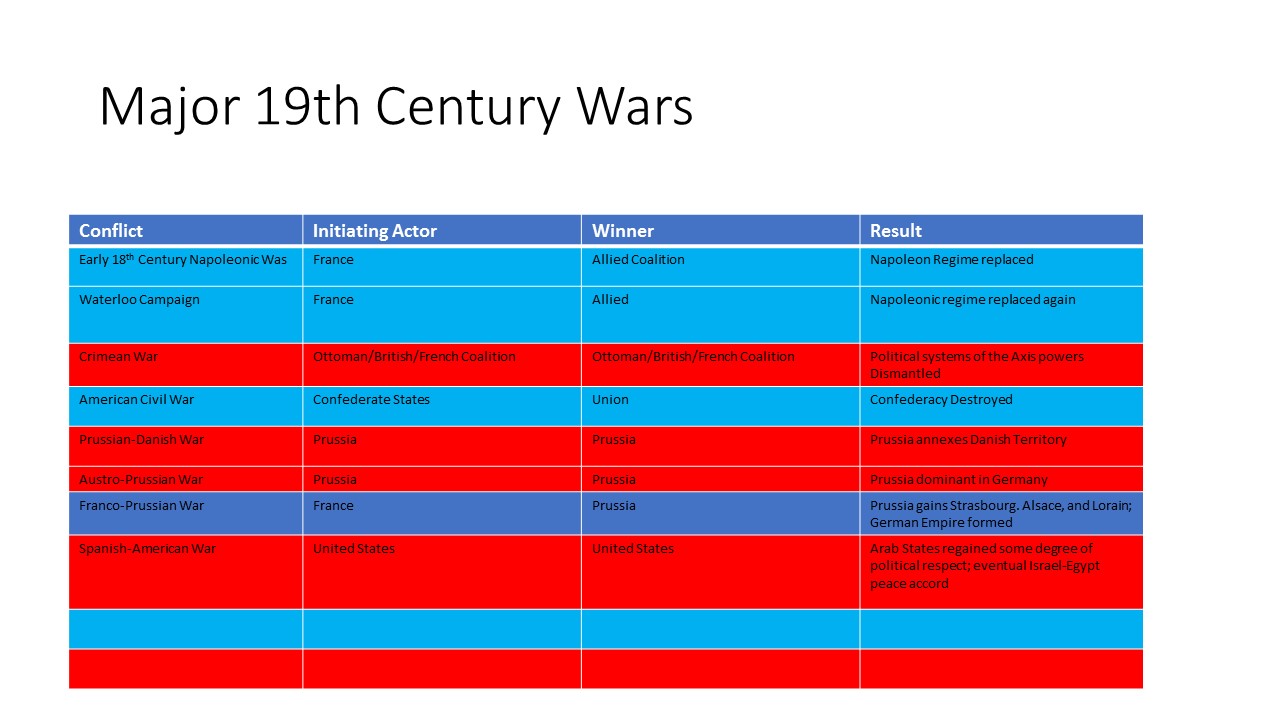
Figure 2. Nineteenth Century Wars were more decisive, but the 50-50 success ratio is clear cut.
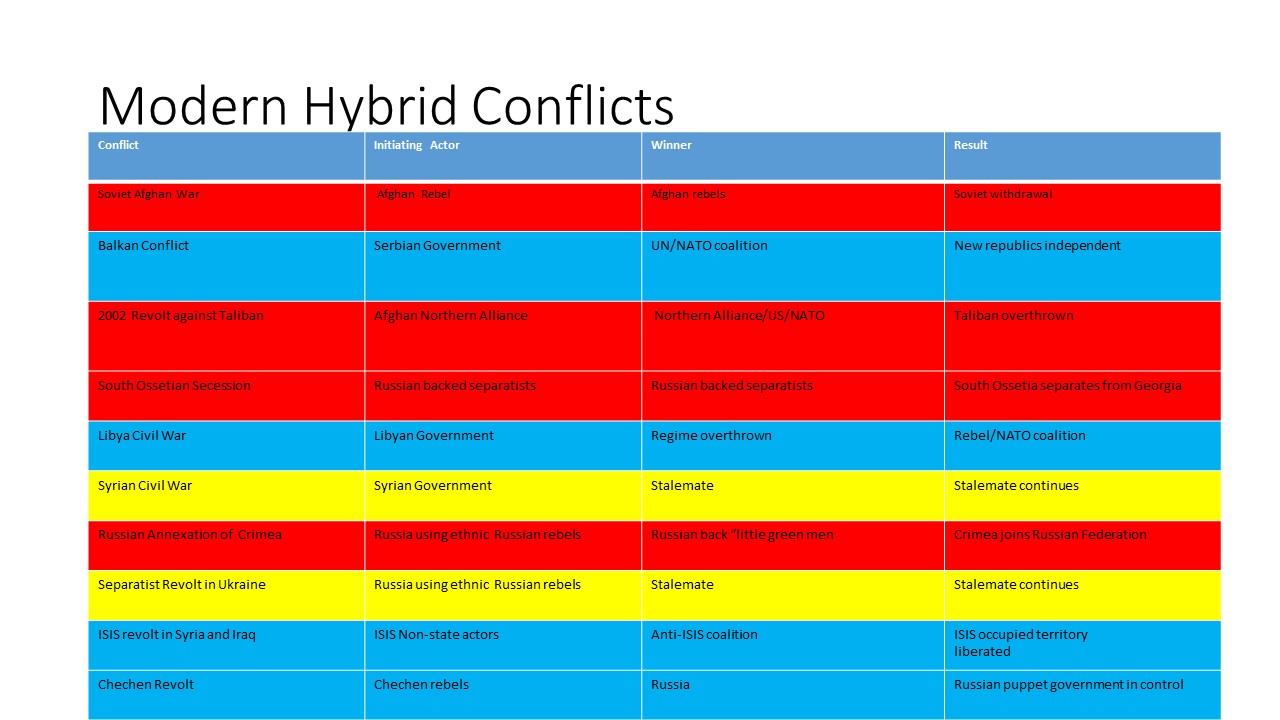
Figure 3. In modern hybrid warfare, the success results for the initiating actor fall to 40% with two ongoing stalemates, but the initiator has less that a coin toss of a chance for a decisive early victory. The 2006 Israeli-Hezbollah War is not included in the above figure because it was the first war in which state actor directly confronted a non-state actor without direct intervention of a third-party state. It is difficult to determine who really started the conflict. Hezbollah incited the Israelis by kidnapping three of their soldiers, but the Israelis initiated the conflict by invading South Lebanon. By fighting the Israelis to a standstill, Hezbollah can be said to have won, but this conflict was not fought in the Gray Zone.
Thus far, post-Cold War state-sponsored hybrid conflicts have been even more disappointing for the initiating actors as shown by Figure 3 above. Starting a conflict that may become a hybrid affair has - to date - been a very risky business proposition.
A second vulnerability is that non-state actors such as militias and mercenaries are very difficult to control. The vast majority of the atrocities in the Balkan war were committed by militias on both sides, but particularly by those supported by Serbia in Bosnia. In Syria, Russian mercenaries (sometimes referred to as” little green men”) have complained bitterly and publicly about incompetent Russian leadership and poor equipment after many were slaughtered in a 2018 US airstrike that threatened a US forward operating base. This was extremely embarrassing to their Russian sponsors.
A final vulnerability is that hybrid actions gone wrong can lead to conventional war if the hybrid kinetic actors can be tied to the state sponsor and public outcry in the world press over atrocities cause a third party “white knight” to directly intervene on behalf of the victim host nation. This was the case in Kosovo in 1999 when a US-led NATO coalition directly waged an air war on Serbia resulting in the collapse of the Serbian government and war crimes trials for several Serbian leaders. The Syrian Civil War and the parallel ISIS conflict have caused several state actors to intervene against ISIS and for as well as against the Syrian government. This has not yet led to a conventional conflict, but it has come close on several occasions.
Centers of Gravity
A state sponsor of a kinetic hybrid campaign must guard his center of gravity which is its ability to support a separatist movement without triggering a conventional kinetic response by the victim state and its allies. A key to this is plausible deniability against triggering international sanctions, UN intervention, or direct US kinetic involvement.
The center of gravity of a victim state is the ability of its security forces to handle a kinetic separatist insurrection with help from its allies. At this writing, the Ukraine has been able to contain the Russian sponsored hybrid separatist conflict on its eastern border with arms and advisory support from friendly states, but it is hampered because it is not a member of NATO and does not have a bilateral agreement with any third party that might allow it to take back territory already lost.
Counter-Hybrid Campaign Design
If the targeted host nation is facing a hybrid threat from a more powerful state-sponsored hybrid threat, it cannot be expected to win the war quickly and decisively in one battle. It will have to retake the disputed territory one piece at a time in something approximating the counterinsurgency ink blot approach. The ideal is for the United States to avoid intervening with conventional forces because such an intervention could lead to a conventional state-on-state conflict. However, the state initiating the hybrid conflict must understand that full US intervention is a possibility if it overplays its hand.
Scenario
For purposes of illustrating campaign design, we will use the situation of the Baltic state of Estonia as a hypothetical scenario. As a former state of the old Soviet Union, Estonia has a significant Russian ethnic minority, one county (Ida-Viru) has a Russian population of over seventy percent and a significant minority of that ethnic group would like reconciliation with Russia. This is a worst-case scenario as Ida-Viru sits on the Russian border; other scenarios get progressively easier to counter. For purposes of this scenario, armed militia units have set up an independent state of Ida-Viru and demanded that Estonian security forces leave. US and Estonian intelligence indicate that the militias are composed of a combination of Russian soldiers in unmarked uniforms (another form of little green Men), Russian contract militia, and local volunteers. The separatists have Russian heavy weapons - to include artillery and surface to air missiles - and outgun local Estonian army and police units.
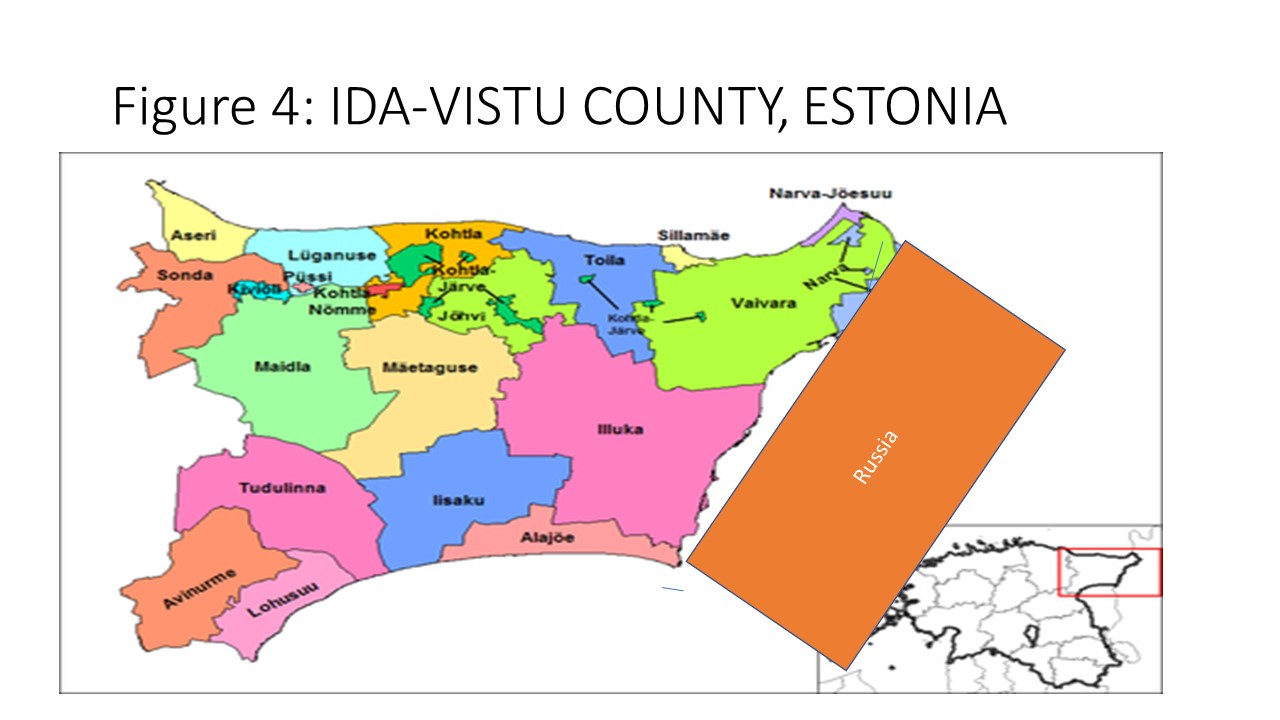
Figure 4. Separatists have gained control of Ida-Vistu County.
The rebels are conducting-information warfare activities to include disinformation, pro-separatist programming and Estonian government and commercial broadcasts to the region. Estonian command and control systems are being jammed.
Phasing
Phase 1 Preparation of the Battlespace. A combination of HN and US assets should be used to suppress rebel air defenses, command and control installations and heavy weapons. Information operations should be conducted to ensure that the population knows what behavior is expected of it. In this example, the battlespace includes the entire county of Estonia. Diplomatic measures should be taken to warn off the state actor (Russia in this case) against direct interference and discouraging other nations to recognize the rebellion as legitimate.
Phase 2. Secure the Border. Secure main supply routes (MSRs) to the border with the state actor and seal the border (in this case the Estonia-Russia Border) from supplies and the passage of military age males from the state actor (Russia) to the HN (Estonia). It is imperative to reinforce the notion of HN sovereignty by control of its frontier. It is preferable to use regular host nation (HN) forces if possible, but if resistance is too heavy for the HN military, US or allied (NATO) regular or special forces may be used. However, where possible, HN police or military forces should maintain security of MSRs with US and allied forces providing clearance of IEDs and suppression of rebel anti-air assets if needed. See Figure 5.

Figure 5. Border control and LOCs established.
Phase 3. Regain and Maintain control of Territory by Security Zones. In this example, we have divided the County up by parishes, but the rule should be that a control zone should have a ratio of 25 security forces for every 1000 of population just as in counterinsurgency. In reality, Ida-Viru County is heavily urban. Consequently, the zones would likely be smaller than the example maps. Depending on the forces available (HN and Allied) there may be activity in multiple zones and different zones may be in multiple stages of activity at any given time. As with counterinsurgency and American politics all hybrid conflicts are local. This phase should begin with zones closest to the border of the state actor that initiated the conflict. (See figure 6) In the example, control would begin by establishing HN and/or allied presence in the three parishes bordering Russia and move west from the Russian border See figure 7). This cuts off the hybrid movement from its source of strength or center of gravity, and begins the process of totally isolating and demoralizing the kinetic forces of the separatist rebels. Control of each zone in this phase should have three stages:
Stage I. Destruction of Rebel Kinetic Capability. This is a combat operation. The zone should be cordoned off during combat operations and services cut off to rebel enclaves. If not killed, rebel detainees should be placed in camps away from the zones where local residents can be sorted out from foreign fighters. Foreign fighters can be eventually repatriated (to Russia in the example). Those HN citizens who wish to take a loyalty oath can do so. Those who do not can be tried for sedition in civilian court or placed in reeducation facilities at the discretion of the HN government.
Stage II. Reestablishment of HN Government Control of the Zone. This stage corresponds roughly with the Hold phase of Counterinsurgency doctrine, but there are important differences. There is no hearts and minds approach here. The ethnic population (Russian in this example) has two choices- they can remain loyal citizens of the HN, or they can emigrate to the state sponsor initiating the conflict if it will have them. This is not ethnic cleansing- it amounts to a clear choice of loyalties by the ethnic minority. If there were instances of discrimination against the ethnic minority that contributed to the situation, it is in the best interest of the HN government to address them.
In this stage, regular military forces in the zone should be replaced by local police or para-military reserve police. This frees up the army and allied combat forces to move on to clear other zones of rebel fighters and it begins the transformation to normalcy. It also allows the zone to be reopened normal commerce with other HN controlled areas to resume normal economic activity.
The HN information operations campaign should emphasize a resumption of legitimate state sovereignty in the area and warning of the consequences of seditious activity.
Stage III. Normalization and Reconstruction. This stage is similar to the Build Phase in Counterinsurgency doctrine. It should mean that conditions are secure enough to allow non-governmental and international organizations to assist in reconstruction of infrastructure and other vital areas in the zone damaged in combat. However, there must be a strong diplomatic effort on the part of US and other allies to warn the state sponsor (Russia in this case) of the consequences of further support to the separatists.

Figure 6: Initial control zones are cleared of Kinetic rebel forces.

Figure 7. Ink Blots of control move west. Note: different zones will be in different stages simultaneously.
End State. The desired end state is the suppression of the separatist movement and the prevention of further interference by the state sponsor (See figure 8).
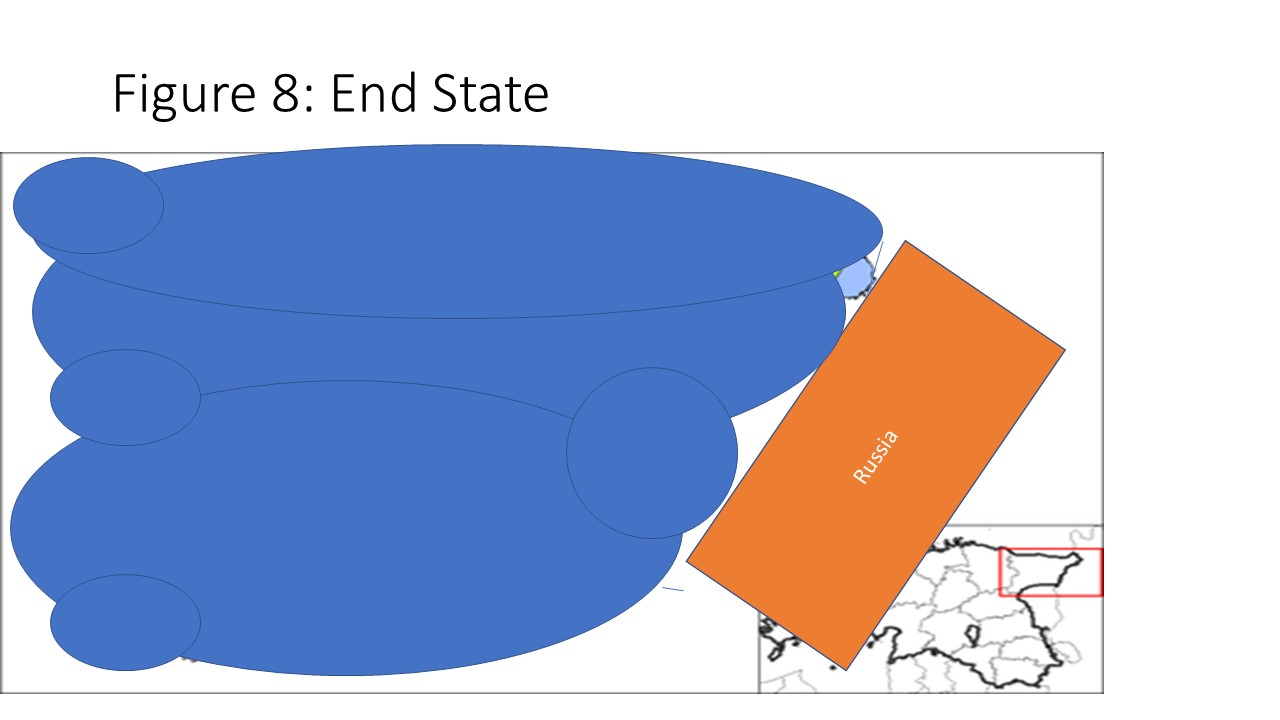
Figure 8. End State.
However, it is possible that the state sponsor (Russia in this example) will overplay its hand and cause a general war. That is a loss for the state sponsor, but not necessarily a victory for US or our HN ally as the conflict will likely be region-wide.
An ideal end state is for the HN with US support to win in the Gray Zone without triggering a general conventional conflict in the process of eliminating the hybrid threat. This is where diplomacy, potential economic sanctions, and information operations on the part of the HN and its allies (US/NATO in the example) can play a strong role in deterrence and prevention.
Conclusion
Russia is the most likely suspect to employ kinetic Hybrid techniques in furthering state objectives in the future, but Iran is not far behind. Iran is currently using kinetic counter-hybrid techniques in Syria and is active in Yemen, Iraq, and Lebanon. It can be expected to support Shiite minorities elsewhere in the Mideast as well. There are sizable Chinese minorities in a number of Southeast Asian countries, but Beijing has not yet used kinetic hybrid techniques to bring them into her orbit. None-the-less, the possibility exists.
Although the United States has used kinetic hybrid techniques to bring down regimes in Afghanistan and Libya, we still lack an effective doctrine for counter-hybrid warfare. This essay has been an attempt to suggest some methods for dealing with such challenges, but it is not definitive. This is a subject that merits serious debate in publications such as this one.
End Notes
[1] "Hybrid threat concept: contemporary war, military planning and the advent of unrestricted operational art" (pdf). United States Army Command and General Staff College. Archived
[2] Examining Complex Forms of Conflict: Gray Zone and Hybrid Challenges Dr. Frank G. Hoffman, PRISM Volume 7 no. 4, Nov. 8, 2018.

